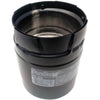Install Instructions For Pellet Stove Vent Pipe Kit With 3 Inch Horizontal Pipe With Vertical Rise With Dura Vent Pro: 3PVP-HZ-KIT-RISE
The pellet venting we sell is Dura-Vent Pellet Vent Pro. Pellet Vent Pro is a twist-lock pellet vent that has an integrated silicon seal within the vent. Simpson Dura-Vent, the pellet venting available in home stores like Home Depot and Lowe's (and we do not sell) is a lower grade pellet venting without the integrated silicon seal. THESE VENTING TYPES ARE MADE BY THE SAME MANUFACTURER BUT THEY CANNOT BE USED TOGETHER AND ARE NOT COMPATIBLE.
General Installation Instructions:
- Place your stove where it is going to be. If your stove requires a hearth pad, make sure the stove is on it.
- Attach your appliance adapter to the stove using the included RTV sealant and at least 1 screw to the collar.
- If you are going up inside the house, attach your clean out T and then build your venting upwards, attach your 90° Elbow and then mark the center point. Mark the center point where the venting meets the wall.
- Using a drill bit that is longer than the depth of the wall, drill your center hole in the wall to the outside.
- The black side of the thimble is the inner section and the galvanized is the exterior section. Using the black half of the thimble, trace it's annular tube at the center point where your hole is. This will be the line for removing the section of the wall. Do the same on the exterior of the wall with the galvanized half of the thimble.
- Attach both halves the the thimble together through the wall.
- Slide your straight length of pipe through the wall thimbles and attach it to the appliance adapter.
- If you are creating your vertical rise on the exterior, just start attaching your venting to find the wall pass-through point, this is where you will cut your hole for the wall thimble. You will attach your clean out T to the venting outside.
- Secure your wall thimble to the wall with screws. Always use exterior rated screws for the outside connection to avoid rust marks from developing.
- Attach your horizontal cap to the end of the venting.
In addition, the following must be observed:
A. The clearance above grade must be a minimum of 12".
B. The clearance to a window or door that may be opened must be a minimum of 48" to the side, 48" below the window/door, 12" above the window/door. (with outside air installed, 9” to the side and below)
C. A 12" clearance to a permanently closed window is recommended to prevent condensation on the window.
D. The vertical clearance to a vented soffit located above the terminal within a horizontal distance of 2 feet (60 cm) from the center-line of the terminal must be a minimum of 18".
E. The clearance to an non-vented soffit must be a minimum of 12".
F. The clearance to an outside corner is 11" from the center of the pipe.
G. The clearance to an inside corner is 12".
H. A vent must not be installed within 3 feet (90 cm) above a gas meter/regulator assembly when measured from the horizontal center-line of the regulator.
I. The clearance to service regulator vent outlet must be a minimum of 6 feet.
J. The clearance to a non-mechanical air supply inlet to the building or the combustion air inlet to any other appliance must be a minimum of 48”.
K. The clearance to a mechanical air supply inlet must be a minimum of 10 feet. (with outside air installed, 6 feet)
L. The clearance above a paved sidewalk or a paved driveway located on public property must be a minimum of 7 feet.
M. The clearance under a veranda, porch, deck or balcony must be a minimum of 12 inches. (B. also)
NOTE: The clearance to vegetation and other exterior combustibles such as mulch is 36” as measured from the center of the outlet or cap. This 36” radius continues to grade.
A vent shall not terminate directly above a sidewalk or paved driveway which is located between two single-family dwellings and serves both dwellings. Only permitted if veranda, porch, deck, or balcony is fully open on a minimum of 2 sides beneath the floor.













